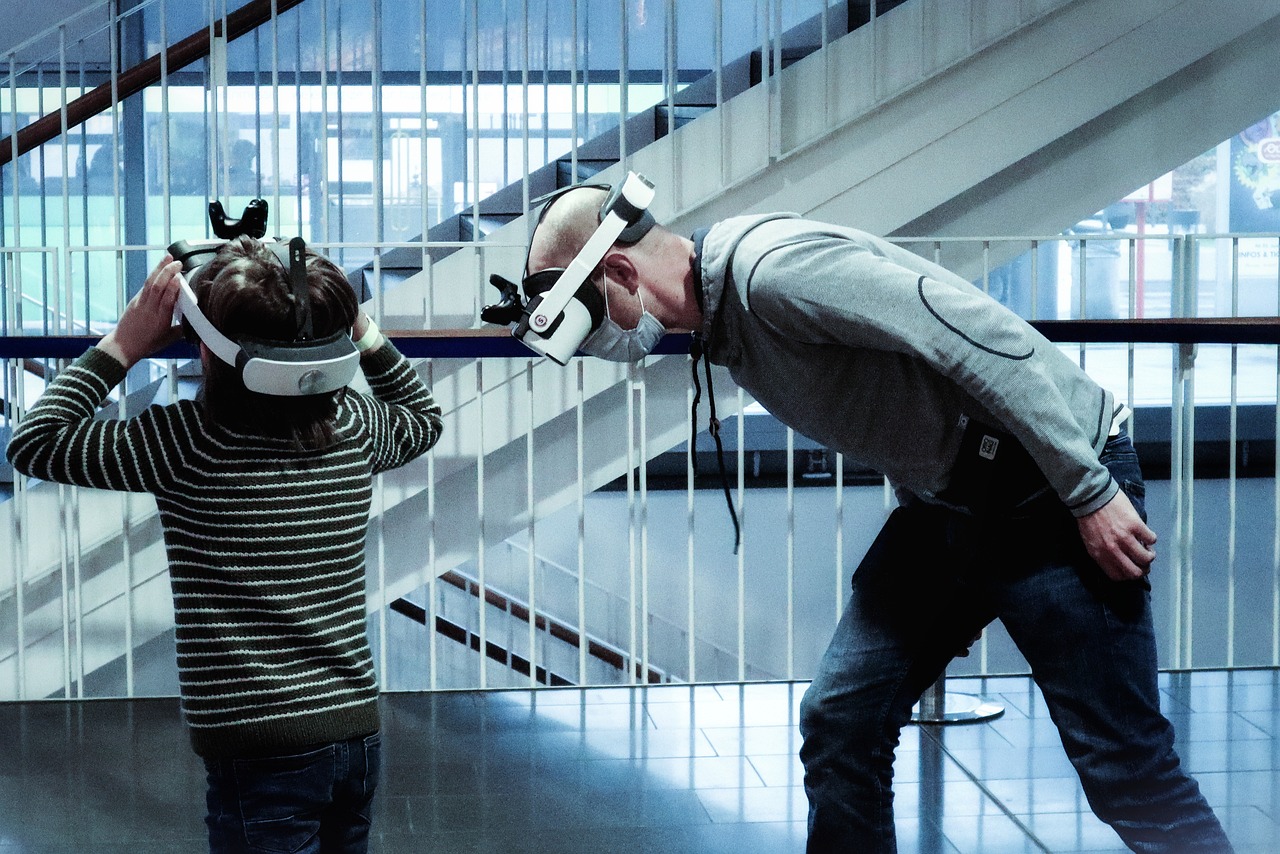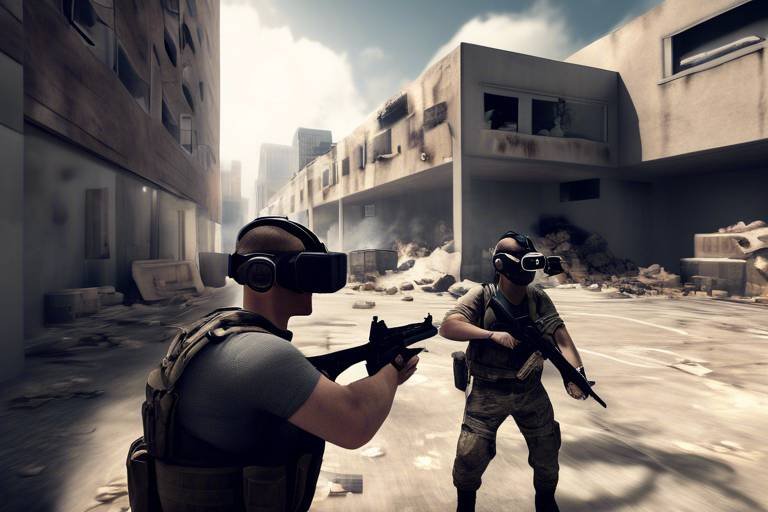How Virtual Reality Supports Decision-Making in Complex Environments
In today’s fast-paced world, making decisions in complex environments can feel like navigating a labyrinth blindfolded. But what if you could take off that blindfold and see the entire maze laid out before you? Virtual Reality (VR) is doing just that—it’s transforming how we approach decision-making by providing immersive experiences that allow users to visualize intricate scenarios. Whether it's in business, healthcare, or urban planning, VR is becoming a game-changer, enabling more informed and confident decisions.
Imagine being able to step into a digital world where you can manipulate variables and see the outcomes of your decisions in real time. That’s the magic of VR! It alters traditional decision-making frameworks by immersing users in a simulated environment where they can explore various scenarios without the risk of real-world consequences. This approach not only enhances understanding but also allows for a more hands-on experience in evaluating options. Users can interact with their surroundings, test hypotheses, and engage in a way that traditional methods simply can't match.
Incorporating VR into corporate strategies is not just a trend; it's a necessity for companies looking to streamline processes and enhance training. For instance, businesses are using VR to create immersive training programs that simulate real-life challenges, allowing employees to practice decision-making in a safe environment. This hands-on experience can significantly improve skills and confidence, leading to better performance in actual situations.
Training programs that utilize VR create realistic simulations that mimic real-world challenges. For example, a company might use VR to train its sales team by simulating customer interactions, enabling employees to practice their responses and strategies without any real-world repercussions. This method not only enhances engagement but also fosters a deeper understanding of the material. Effective training models leveraging VR technology include:
- Scenario-Based Learning: Employees navigate through various scenarios that require critical thinking and quick decision-making.
- Feedback Mechanisms: Instant feedback helps employees learn from their mistakes and improve their decision-making skills.
- Collaborative Training: Teams can train together in a virtual environment, enhancing communication and teamwork.
Real-world examples illustrate how companies have successfully integrated VR into their training programs. For instance, a major airline implemented a VR training program for its pilots, allowing them to experience emergency scenarios in a safe environment. This resulted in not only improved decision-making skills but also increased confidence during actual flights. Similarly, a healthcare provider used VR to train surgeons, enabling them to practice complex procedures without the risk associated with real patients.
Despite its advantages, VR training is not without challenges. Some organizations face high costs associated with VR technology and the need for specialized equipment. Additionally, there are technological limitations, such as the need for high-quality graphics and immersive experiences that can sometimes be difficult to achieve. Overcoming these obstacles is crucial for organizations looking to adopt VR for training purposes, but the potential benefits far outweigh the challenges.
One of the most exciting aspects of VR is its ability to foster collaboration among remote teams. Imagine a team of professionals from different corners of the globe coming together in a virtual space to brainstorm and make decisions in real time. VR tools and platforms facilitate this collaborative decision-making process, allowing teams to visualize data and scenarios together, leading to more effective problem-solving and innovation.
The advantages of VR extend beyond mere visualization; it enhances engagement and retention of information. When users are fully immersed in a virtual environment, they are more likely to remember what they learn and apply it effectively. Key benefits of VR in complex decision-making scenarios include:
VR enables users to simulate potential risks in a controlled environment, aiding in better risk evaluation. By experiencing various outcomes in a virtual setting, decision-makers can assess the implications of their choices more comprehensively. This ability to visualize risks and their consequences can lead to more informed and confident decisions.
Effective decision-making relies heavily on data interpretation. VR enhances data visualization, making complex data sets easier to understand and analyze. For example, a company might use VR to create 3D models of their data, allowing decision-makers to interact with the information in a way that traditional charts and graphs simply cannot provide. This immersive approach not only simplifies analysis but also allows for deeper insights and more informed decisions.
Q: How does VR improve decision-making?
A: VR enhances decision-making by providing immersive experiences that allow users to visualize complex scenarios and evaluate outcomes in a risk-free environment.
Q: What industries benefit the most from VR?
A: Industries such as healthcare, aviation, and corporate training have seen significant benefits from VR applications, particularly in training and development.
Q: Are there any challenges in implementing VR?
A: Yes, challenges include high costs, technological limitations, and the need for specialized equipment, but the advantages often outweigh these obstacles.

The Role of Virtual Reality in Decision-Making
Virtual reality (VR) is not just a futuristic concept anymore; it has become a transformative tool in the realm of decision-making. Imagine stepping into a world where you can visualize complex scenarios as if you were living them. This immersive experience allows users to interact with 3D environments, making it easier to understand intricate situations that might be overwhelming in a traditional setting. By altering the way we perceive information, VR empowers individuals to make more informed decisions based on realistic simulations.
One of the most significant ways VR enhances decision-making is through its ability to create immersive simulations that mirror real-life challenges. Traditional decision-making processes often rely on static data and 2D presentations, which can be limiting. In contrast, VR provides a dynamic platform where users can engage with data in a more interactive manner. For instance, a business leader can visualize market trends in a 3D space, allowing them to grasp the implications of various strategies in real-time.
Moreover, VR helps in breaking down complex information into manageable parts. By allowing users to explore different aspects of a situation, they can identify potential outcomes and consequences more effectively. This is particularly useful in fields like healthcare, where surgeons can practice procedures in a virtual environment before performing them on actual patients. The ability to rehearse and analyze different scenarios without real-world repercussions leads to better preparedness and confidence in decision-making.
Additionally, VR fosters a deeper level of engagement. When users are fully immersed in a virtual environment, they are more likely to retain information and remain focused on the task at hand. This heightened level of engagement translates into improved decision-making capabilities, as individuals can concentrate on the critical aspects of a situation without distractions. A study conducted by Stanford University found that participants who used VR for training were able to recall information significantly better than those who learned through traditional methods.
In essence, the role of virtual reality in decision-making is multifaceted. It not only enhances visualization and engagement but also promotes collaboration among teams, especially in remote settings. By providing a shared virtual space, team members can discuss and evaluate decisions collectively, leading to more comprehensive outcomes. As we continue to explore the potential of VR, it’s clear that this technology is reshaping the landscape of decision-making in complex environments.

Applications of VR in Business Environments
Virtual reality (VR) is revolutionizing the way businesses operate, providing innovative solutions to enhance decision-making processes. Imagine stepping into a digital world where you can visualize and interact with complex data, all while collaborating with your team in real time. This immersive technology is not just a futuristic concept; it's a practical tool that companies are leveraging to gain a competitive edge. From training to project management, VR applications are diversifying the business landscape in ways we never thought possible.
One of the standout applications of VR in business is in the realm of training and development. Traditional training methods often fall short when it comes to engaging employees or providing them with realistic scenarios to practice their skills. With VR, organizations can create lifelike simulations that mimic real-world challenges. For instance, a VR training module might immerse employees in a high-pressure sales environment, allowing them to hone their negotiation skills without the risk of losing a deal. This hands-on approach not only boosts confidence but also enhances knowledge retention, making training sessions more effective.
Moreover, VR is proving invaluable in project management. Teams can utilize VR platforms to visualize project plans in 3D, facilitating better understanding and communication. Imagine a construction team being able to walk through a virtual model of a building before it's even constructed. This capability allows teams to identify potential issues and make informed decisions about design and resource allocation. The ability to visualize projects in a virtual space can lead to more efficient planning and execution, ultimately saving time and money.
Additionally, VR is enhancing the customer experience. Businesses are using VR to create immersive marketing campaigns that allow customers to interact with products in a virtual environment. For example, a furniture store might offer a VR experience where customers can visualize how a piece of furniture would look in their own home. This not only engages customers but also aids in their decision-making process, leading to higher conversion rates.
However, the integration of VR into business strategies is not without its challenges. High costs associated with VR technology and the need for specialized training to use these tools can be significant barriers. Companies must weigh the potential benefits against these challenges to determine if VR is a viable option for their specific needs. Despite these hurdles, the potential for VR to transform decision-making processes in business environments is immense.
In summary, the applications of VR in business environments are vast and varied. From training and project management to enhancing customer experiences, VR is reshaping how companies operate and make decisions. As the technology continues to evolve, we can expect even more innovative applications that will further enhance decision-making capabilities in complex business landscapes.
- What industries can benefit from VR applications? Virtually any industry, including healthcare, education, real estate, and manufacturing, can leverage VR for training, simulations, and enhanced decision-making.
- Is VR technology expensive to implement? While initial costs can be high, many businesses find that the long-term benefits, such as improved training outcomes and increased efficiency, justify the investment.
- Can VR be used for remote collaboration? Absolutely! VR platforms enable teams to collaborate in a virtual space, making it easier to share ideas and make decisions regardless of physical location.

VR in Training and Development
In today’s fast-paced world, the need for effective training solutions is more critical than ever. Traditional training methods often fall short, leaving employees unprepared for the complexities of real-world scenarios. This is where Virtual Reality (VR) steps in, revolutionizing the way organizations approach training and development. By immersing employees in realistic simulations, VR allows them to practice decision-making in a safe environment, free from the repercussions of real-world mistakes.
Imagine being a pilot training for a complex flight maneuver. Instead of reading manuals or watching videos, what if you could actually experience the cockpit environment? With VR, trainees can engage in lifelike simulations that replicate the conditions they will face in their jobs. This hands-on approach not only boosts confidence but also accelerates the learning process. Employees can encounter various scenarios, from handling customer complaints to managing emergency situations, all within a controlled setting.
Moreover, VR training programs can be tailored to meet the specific needs of different industries. For instance, in the healthcare sector, medical professionals can practice surgical procedures using VR simulations, allowing them to refine their skills without putting patients at risk. In the manufacturing industry, workers can learn to operate machinery or respond to hazardous situations, all while receiving immediate feedback on their performance. This adaptability makes VR an invaluable tool for enhancing employee readiness.
To illustrate the effectiveness of VR in training, let’s consider a few key benefits:
- Realistic Scenarios: Trainees experience lifelike situations that closely mirror their actual work environment.
- Immediate Feedback: VR systems can track performance in real-time, providing instant feedback for improvement.
- Increased Engagement: The immersive nature of VR keeps employees engaged, making learning more enjoyable and effective.
- Cost-Effective Training: By reducing the need for physical resources and allowing for repeated practice, VR can lower training costs in the long run.
Despite these advantages, it’s important to acknowledge the challenges that organizations may face when implementing VR training. High initial costs for technology and content development can be a barrier for some companies. Additionally, there may be a learning curve for both trainers and trainees as they adapt to this new method of learning. However, the long-term benefits often outweigh these initial hurdles, making VR a worthwhile investment.
As we look to the future, the potential for VR in training and development seems limitless. With advancements in technology, we can expect even more realistic and interactive training experiences. Companies that embrace VR not only enhance their training programs but also position themselves as leaders in their respective industries, ready to tackle the complexities of the modern workplace.

Case Studies of Successful Implementation
When it comes to the adoption of virtual reality (VR) in decision-making processes, several companies stand out for their innovative approaches and tangible results. One such example is Walmart, which has integrated VR into its training programs to enhance employee skills and decision-making capabilities. By using VR simulations, Walmart allows employees to experience real-life scenarios, such as managing customer service challenges or handling emergencies, without the risk of actual consequences. This hands-on experience not only boosts their confidence but also improves their ability to make quick, informed decisions in high-pressure situations.
Another notable case is Ford Motor Company, which employs VR technology to streamline its design and engineering processes. By creating virtual prototypes of vehicles, Ford can evaluate design decisions early in the development cycle. This not only saves time and resources but also facilitates better collaboration among teams. Engineers and designers can immerse themselves in a virtual environment, allowing them to visualize and manipulate the vehicle's design in real-time. As a result, the decision-making process becomes more efficient, leading to innovative designs that meet consumer expectations.
Moreover, the healthcare sector has seen significant advancements through VR. Osso VR, a surgical training platform, uses VR to provide immersive training experiences for surgeons. By simulating complex surgical procedures, Osso VR enables medical professionals to practice and refine their skills in a risk-free environment. This not only enhances their decision-making abilities during surgeries but also contributes to better patient outcomes. Studies have shown that surgeons who train with VR exhibit improved performance in real-world procedures, showcasing the effectiveness of this technology in critical decision-making scenarios.
To further illustrate the impact of VR on decision-making, let’s take a look at a comparative analysis of these companies:
| Company | Application of VR | Outcome |
|---|---|---|
| Walmart | Employee training simulations | Improved confidence and decision-making under pressure |
| Ford | Virtual vehicle prototypes | Streamlined design process and enhanced collaboration |
| Osso VR | Surgical training simulations | Better surgical performance and patient outcomes |
These case studies highlight the transformative power of VR in various industries. By providing immersive experiences, VR not only improves the skills of individuals but also enhances the overall decision-making process within organizations. As more companies recognize the potential of VR, we can expect to see an increasing number of successful implementations that further validate its role in complex environments.
- What is virtual reality?
Virtual reality is a computer-generated simulation of a three-dimensional environment that can be interacted with using special electronic equipment, such as VR headsets.
- How does VR improve decision-making?
VR enhances decision-making by providing immersive experiences that allow users to visualize complex scenarios, practice skills, and assess risks in a controlled environment.
- What industries benefit from VR?
Industries such as healthcare, automotive, retail, and education have successfully integrated VR to improve training, design processes, and collaboration.
- Are there challenges in implementing VR?
Yes, challenges include high costs, technological limitations, and the need for specialized training to effectively use VR tools.

Challenges in VR Training
While the potential of Virtual Reality (VR) in training is undeniably exciting, several challenges hinder its widespread adoption. One of the most significant obstacles is the cost associated with the technology. High-quality VR hardware and software can be quite expensive, making it difficult for smaller organizations to invest in these resources. Additionally, the ongoing maintenance and updates required to keep VR systems running smoothly can add to the financial burden.
Another challenge is the technological limitations that come with VR. Not all employees may be comfortable using VR technology, which can lead to a steep learning curve. This is especially true for older employees or those who are not tech-savvy. Furthermore, the quality of VR experiences can vary widely depending on the platform and equipment used. Subpar experiences can lead to frustration and disengagement, ultimately negating the benefits of VR training.
Moreover, there is a risk of over-saturation in the market. As more companies jump on the VR bandwagon, the novelty of the technology may wear off, leading to diminishing returns. Organizations must find ways to continually innovate and keep their training programs fresh and engaging. Otherwise, employees may lose interest and fail to fully benefit from the immersive experiences that VR offers.
Lastly, the challenge of content creation cannot be overlooked. Developing high-quality VR training modules requires specialized skills and knowledge. Many companies may not have the in-house expertise necessary to create these experiences, leading them to rely on external vendors. This can complicate the training process and increase costs further.
In summary, while VR holds great promise for enhancing training and decision-making, organizations must navigate several challenges, including:
- Cost: High initial investment and ongoing maintenance expenses.
- Technological limitations: Learning curves and varying quality of experiences.
- Market saturation: Potential loss of engagement over time.
- Content creation: Need for specialized skills and resources.
Addressing these challenges requires a strategic approach, focusing on long-term benefits and continual improvement of VR training programs. By doing so, organizations can harness the full potential of VR to enhance decision-making and training outcomes.
- What is VR training? VR training uses immersive virtual environments to simulate real-world scenarios, allowing users to practice skills and make decisions without real-life consequences.
- What are the benefits of VR in training? Benefits include enhanced engagement, improved retention of information, and the ability to practice decision-making in a safe, controlled environment.
- Are there any downsides to using VR for training? Yes, challenges include high costs, technological limitations, and the need for specialized content creation.
- How can organizations overcome the challenges of VR training? By investing in quality technology, providing training for users, and continuously updating content to keep it engaging.

Enhancing Collaboration through VR
In today's fast-paced world, where remote work has become the norm, collaboration can sometimes feel like trying to put together a jigsaw puzzle with missing pieces. Enter Virtual Reality (VR), a game-changer that brings teams together, regardless of their physical locations. With VR, collaboration transforms from a simple video call into an immersive experience that mimics in-person interactions. Imagine being able to brainstorm ideas in a virtual conference room, share 3D models, or even walk through a virtual space together, all while feeling like you're in the same room. This is the magic of VR!
One of the standout features of VR is its ability to create a shared virtual space where team members can interact in real-time. This is particularly beneficial for industries like architecture, engineering, and design, where visualizing complex projects is crucial. For example, a team working on a new building can don their VR headsets and explore a virtual model of the structure, discussing design elements and making decisions on the fly. This level of engagement is not only more effective than traditional methods but also fosters a sense of presence and teamwork that can be hard to replicate through standard communication tools.
Moreover, VR platforms are equipped with tools that enhance collaborative decision-making. Features such as virtual whiteboards, 3D object manipulation, and real-time editing capabilities allow teams to brainstorm and visualize ideas dynamically. For instance, during a product development meeting, team members can interact with a virtual prototype, making adjustments and seeing immediate results. This hands-on approach not only speeds up the decision-making process but also ensures that all voices are heard, as everyone can contribute their insights in an engaging manner.
However, it's important to note that while VR enhances collaboration, it also requires a shift in mindset and investment in technology. Organizations need to provide proper training for their employees to maximize the benefits of VR collaboration tools. This means understanding how to navigate virtual environments, utilize collaboration features effectively, and integrate VR into existing workflows. By doing so, companies can unlock a new level of synergy among their teams.
To illustrate the impact of VR on collaboration, consider the following table showcasing various VR collaboration tools and their features:
| VR Tool | Features | Best For |
|---|---|---|
| Spatial | Virtual meeting rooms, 3D object sharing, whiteboarding | Creative teams, design reviews |
| Engage | Webinars, training sessions, interactive presentations | Education, corporate training |
| AltspaceVR | Social VR events, meetups, networking | Community building, networking events |
In conclusion, VR is not just a flashy gimmick; it's a powerful tool that enhances collaboration in ways we never thought possible. By breaking down geographical barriers and creating immersive experiences, VR allows teams to connect, innovate, and make informed decisions together. As technology continues to evolve, the potential for VR in collaborative environments is limitless, paving the way for a future where distance is no longer a barrier to effective teamwork.
- What is Virtual Reality? Virtual Reality (VR) is a simulated experience that can be similar to or completely different from the real world, allowing users to immerse themselves in a virtual environment.
- How does VR enhance collaboration? VR enhances collaboration by creating shared virtual spaces where teams can interact in real-time, visualize complex projects, and make decisions together, regardless of their physical locations.
- What industries benefit from VR collaboration tools? Industries such as architecture, engineering, design, education, and corporate training benefit significantly from VR collaboration tools.
- Are there any challenges to implementing VR in collaboration? Yes, challenges include the need for proper training, investment in technology, and ensuring that team members are comfortable using VR tools.

Benefits of Virtual Reality in Complex Environments
The benefits of Virtual Reality (VR) in complex environments are as diverse as they are impactful. Not only does VR provide an immersive experience that captures the user's attention, but it also enhances engagement and retention of information. Imagine being able to step into a virtual world where you can manipulate data and visualize scenarios that would be impossible in the real world. This is where VR shines, transforming the way we approach decision-making in intricate settings.
One of the most significant advantages of VR is its ability to create a safe environment for experimentation. In traditional settings, making decisions often comes with real-world consequences that can be costly or risky. With VR, users can simulate various outcomes without the fear of negative repercussions. For instance, in sectors like healthcare, professionals can practice surgical procedures in a virtual setting, honing their skills before they ever touch a patient. This not only boosts their confidence but also leads to better outcomes in real-life situations.
Moreover, VR facilitates collaborative decision-making among teams, especially in remote work scenarios. Picture a group of engineers from different parts of the world coming together in a virtual conference room, analyzing a complex project in real-time. This not only enhances communication but also allows for a more dynamic exchange of ideas, leading to well-rounded decisions. The technology breaks down geographical barriers, ensuring that the best minds can work together regardless of their physical location.
Additionally, VR excels in data visualization and analysis. Complex data sets can often be overwhelming, but when represented in a virtual space, they become more digestible. Users can interact with the data, zooming in on details, rotating graphs, and even simulating various scenarios based on the data inputs. This hands-on approach allows for a deeper understanding of the information, enabling more informed decision-making. Companies that leverage VR for data analysis often find that their teams can identify trends and insights that might have been missed in traditional formats.
Furthermore, VR enhances risk assessment capabilities. By simulating potential risks in a controlled environment, users can evaluate various scenarios and their potential outcomes. This is particularly beneficial in industries like finance or construction, where understanding the implications of a decision can save time and resources. With VR, decision-makers can visualize risks and prepare contingency plans, ultimately leading to better strategic planning.
In summary, the integration of VR into complex environments offers a multitude of benefits that extend far beyond mere visualization. It enhances engagement, fosters collaboration, simplifies data analysis, and improves risk assessment. As organizations continue to embrace this technology, they will undoubtedly uncover even more innovative applications that can revolutionize decision-making processes.
- What industries can benefit from VR in decision-making?
Industries such as healthcare, finance, construction, and education can significantly benefit from VR, as it allows for risk-free simulations and enhanced collaborative efforts.
- How does VR improve data visualization?
VR allows users to interact with complex data in a 3D space, making it easier to understand and analyze trends or patterns that might be overlooked in traditional 2D formats.
- What are the challenges of implementing VR in organizations?
Challenges include high costs, the need for specialized hardware and software, and potential resistance from employees who may be unfamiliar with the technology.

Improved Risk Assessment
In today's fast-paced world, risk assessment has become an essential part of decision-making, particularly in complex environments. Virtual reality (VR) steps in as a game changer by allowing users to immerse themselves in simulated scenarios where they can visualize potential risks without facing real-world consequences. Imagine being able to walk through a virtual construction site where you can spot hazards before they become a problem. This immersive experience not only enhances understanding but also fosters a proactive approach to risk management.
One of the most significant advantages of using VR for risk assessment is the ability to conduct what-if analyses. Users can manipulate various parameters in a safe environment, observing how changes affect outcomes. For instance, a team assessing a new product launch can simulate different market conditions and consumer reactions, enabling them to identify potential pitfalls before they occur. This kind of foresight is invaluable, as it allows organizations to make adjustments early in the process, thereby minimizing potential losses.
Moreover, VR enhances collaboration among team members during risk assessment sessions. By bringing together remote participants into a shared virtual space, teams can discuss and analyze risks collectively, leading to more comprehensive evaluations. This collaborative approach not only improves the quality of the assessments but also ensures that all stakeholders have a voice in the decision-making process. Teams can utilize VR platforms that allow for real-time interaction, making the experience more engaging and productive.
To illustrate the effectiveness of VR in risk assessment, consider the following table showcasing various industries and how they utilize VR for risk evaluation:
| Industry | Application of VR in Risk Assessment |
|---|---|
| Construction | Identifying site hazards and safety compliance |
| Healthcare | Simulating patient scenarios for emergency preparedness |
| Finance | Modeling market fluctuations and investment risks |
| Manufacturing | Evaluating equipment failures and safety protocols |
While the benefits of VR in risk assessment are clear, it’s important to acknowledge that there are challenges involved. High costs of VR technology and the need for specialized training can be barriers for some organizations. However, as technology advances and becomes more accessible, the potential for VR to revolutionize risk assessment in complex environments is immense. By embracing these innovations, organizations can not only enhance their decision-making processes but also create safer and more efficient workplaces.
In conclusion, the integration of virtual reality into risk assessment practices represents a significant leap forward in how organizations approach decision-making. By providing an immersive platform to simulate risks and facilitate collaboration, VR empowers teams to make more informed choices. As we continue to explore the future of VR in various fields, it’s clear that the potential for improved risk assessment is just the tip of the iceberg.
- What is virtual reality? Virtual reality (VR) is a simulated experience that can be similar to or completely different from the real world, often achieved through the use of VR headsets.
- How does VR improve risk assessment? VR allows users to visualize and simulate potential risks in a controlled environment, enabling better understanding and proactive decision-making.
- What industries benefit from VR in risk assessment? Industries such as construction, healthcare, finance, and manufacturing are leveraging VR for enhanced risk evaluation.
- Are there challenges in implementing VR for risk assessment? Yes, challenges include high costs and the need for specialized training, but advancements in technology are making it more accessible.

Data Visualization and Analysis
When it comes to making informed decisions in complex environments, the ability to visualize data effectively is paramount. Virtual reality (VR) takes data visualization to a whole new level, transforming raw numbers and statistics into immersive, interactive experiences. Imagine being able to step inside your data, walking through 3D models that represent trends, patterns, and relationships. This kind of engagement not only makes the information more digestible but also enhances understanding and retention.
One of the key benefits of using VR for data visualization is its capacity to simplify complex datasets. Traditional 2D charts and graphs can often leave decision-makers struggling to grasp the full picture. In contrast, VR can present data in a spatial context, allowing users to manipulate variables and see real-time results. For example, a company analyzing sales data can create a virtual environment where different sales strategies are visualized, enabling teams to explore the impact of each approach dynamically.
Furthermore, VR can incorporate multi-dimensional data analysis, making it easier to identify correlations and anomalies that might be overlooked in conventional formats. By layering data sets, users can interactively explore various scenarios, such as how changes in market conditions could affect sales performance. This capability is particularly useful in fields like finance, healthcare, and logistics, where decisions often hinge on complex interdependencies.
| Feature | Traditional Visualization | VR Visualization |
|---|---|---|
| Interactivity | Limited | High |
| Data Complexity | 2D representation | 3D immersive experience |
| User Engagement | Passive | Active participation |
| Real-Time Analysis | Static | Dynamic |
Moreover, VR excels in presenting data in a way that tells a story. When users can visualize data trends over time, they are more likely to understand the implications of their findings. This narrative aspect of data visualization is crucial for persuading stakeholders and aligning teams around a common goal. Imagine a marketing team being able to visualize customer journey data in a virtual space, allowing them to identify pain points and opportunities for improvement in real-time.
However, while VR offers remarkable potential for data visualization and analysis, it’s essential to recognize the importance of design and usability. A poorly designed VR experience can lead to confusion rather than clarity. Therefore, organizations must invest in creating intuitive interfaces and ensuring that users are adequately trained to navigate these virtual environments. The key is to balance sophistication with accessibility, making sure that the technology serves to enhance understanding rather than complicate it.
In conclusion, the integration of VR into data visualization and analysis significantly enhances decision-making processes. It transforms how data is perceived and interacted with, enabling users to explore complex datasets in a more meaningful way. As technology continues to evolve, the potential for VR to reshape decision-making in various fields is not just a possibility; it's an exciting reality waiting to unfold.
- What is virtual reality (VR)? VR is a simulated experience that can be similar to or completely different from the real world, often involving the use of special equipment like headsets.
- How does VR improve data visualization? VR allows users to interact with data in a 3D space, making complex information easier to understand and analyze.
- What industries can benefit from VR data visualization? Industries such as finance, healthcare, marketing, and logistics can greatly benefit from enhanced data visualization through VR.
- Are there any challenges associated with VR data visualization? Yes, challenges include high costs, the need for specialized training, and potential technological limitations.
Frequently Asked Questions
- What is Virtual Reality (VR) and how does it aid decision-making?
Virtual Reality (VR) is an immersive technology that creates a simulated environment, allowing users to experience and interact with 3D spaces. It aids decision-making by providing realistic scenarios where individuals can visualize outcomes and assess options without real-world consequences, leading to more informed choices.
- How is VR used in business training?
In business training, VR is utilized to create realistic simulations that replicate real-life challenges. This hands-on approach enables employees to practice their decision-making skills in a safe environment, enhancing their ability to respond effectively in actual situations.
- What are the benefits of using VR for complex decision-making?
The benefits of using VR for complex decision-making include enhanced engagement, improved information retention, and better risk assessment. By immersing users in a controlled environment, VR allows for thorough analysis of potential risks and a clearer understanding of complex data sets.
- Can VR improve collaboration among remote teams?
Absolutely! VR fosters collaboration among remote teams by creating virtual spaces where team members can meet and interact in real-time. This technology breaks down geographical barriers, enabling effective decision-making and brainstorming sessions as if everyone were in the same room.
- What challenges do organizations face when implementing VR training?
Organizations may encounter several challenges when implementing VR training, including high costs of VR equipment and software, the need for specialized training to use the technology, and potential technological limitations that could hinder the training experience.
- How does VR enhance data visualization?
VR enhances data visualization by transforming complex data sets into interactive 3D models. This approach allows users to explore and analyze data in a more intuitive way, making it easier to identify patterns, trends, and insights that can inform decision-making.



















